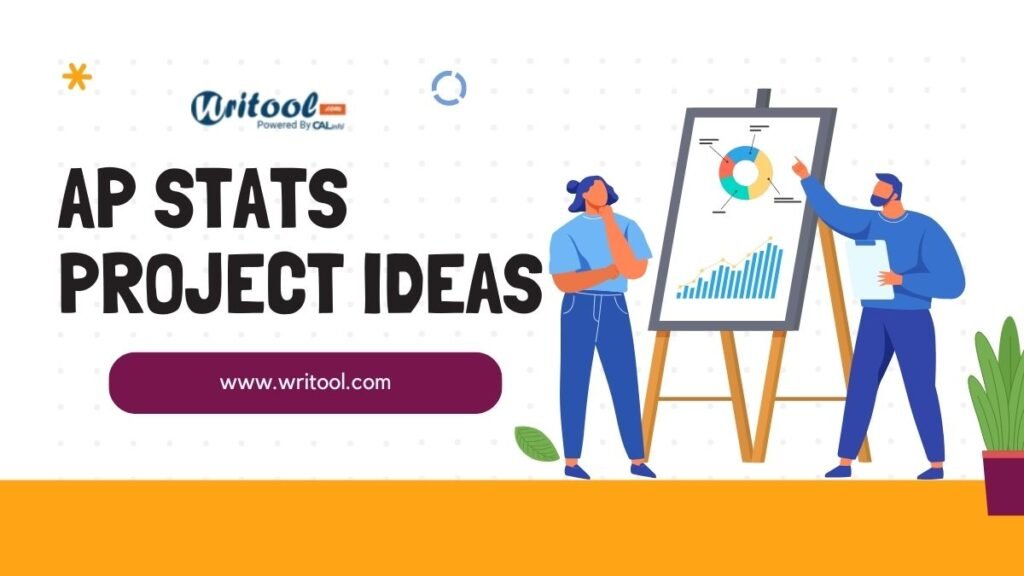Embark on a journey of statistical discovery with captivating AP Stats project ideas! Whether you’re analyzing trends or designing experiments, there’s a plethora of creative projects to elevate your understanding of statistics.
Hey there! Ever feel like the world’s drowning in data? Well, stats is like your secret decoder ring—it helps make sense of all that info! Remember all that cool stuff you learned in AP Stats? It’s time to flex those brain muscles with a project!
I’ve got a bunch of awesome project ideas lined up for you. Whether you’re into everyday stuff (like snooze habits affecting grades) or you’re up for a challenge (hello, predicting the stock market!), there’s something here to pique your interest.
So, dive on in, ask some cool questions, and share your findings in a way that even your grandma would get. Let’s make stats fun, shall we?
AP Stats Project Ideas
Check out AP stats project ideas:-
Descriptive Statistics
- Analyze ages in a population dataset.
- Examine monthly rainfall data.
- Investigate average daily temperature.
- Compare test score distributions.
- Analyze height distribution among students.
Inferential Statistics
- Test new teaching method effectiveness.
- Analyze exercise impact on weight loss.
- Investigate study hours vs. GPA.
- Correlate smoking with lung cancer.
- Compare medication effectiveness.
Probability
- Simulate dice outcomes.
- Analyze game-winning probabilities.
- Examine coin flip probabilities.
- Investigate card drawing probabilities.
- Simulate sports tournament outcomes.
Regression Analysis
- Predict housing prices based on factors.
- Analyze income and education correlation.
- Investigate advertising impact on sales.
- Predict student performance factors.
- Examine temperature vs. ice cream sales.
Experimental Design
- Test new fertilizer on plant growth.
- Conduct blind soda taste test.
- Investigate study technique impact.
- Test new traffic signal system.
- Analyze packaging impact on sales.
Survey Analysis
- Assess environmental issue opinions.
- Analyze voting pattern survey.
- Investigate smartphone feature preferences.
- Gauge online learning attitudes.
- Analyze travel behavior trends.
Time Series Analysis
- Analyze monthly sales data.
- Investigate unemployment rate trends.
- Examine tourist arrival patterns.
- Analyze quarterly GDP growth.
- Investigate stock price trends.
Hypothesis Testing
- Compare test scores between schools.
- Analyze gender differences in math.
- Test new vs. traditional teaching.
- Compare airline customer satisfaction.
- Correlate age with income.
Categorical Data Analysis
- Analyze political affiliation distribution.
- Investigate pet type prevalence.
- Examine blood type distribution.
- Analyze workplace accident types.
- Investigate college major distribution.
Bayesian Statistics
- Estimate rare event probabilities.
- Model variable relationships.
- Estimate medical test accuracy.
- Update beliefs with new evidence.
- Estimate business venture success.
Spatial Analysis
- Map wildlife population distribution.
- Analyze crime spatial patterns.
- Study contagious disease spread.
- Map air pollution distribution.
- Investigate earthquake epicenters.
Multivariate Analysis
- Analyze income, education, health links.
- Investigate advertising, quality, sales links.
- Study temperature, humidity, air quality.
- Analyze voter turnout factors.
- Investigate customer satisfaction, loyalty, purchases.
Data Visualization
- Create music genre popularity bar chart.
- Design age vs. income scatter plot.
- Make smartphone OS distribution pie chart.
- Design exam score histogram.
- Create temperature trend line graph.
Predictive Modeling
- Predict sales using linear regression.
- Model customer churn likelihood.
- Predict loan default likelihood.
- Forecast stock prices using neural network.
- Predict customer preferences using decision trees.
Experimental Simulation
- Simulate virus spread.
- Estimate pi using Monte Carlo.
- Simulate coin flip outcomes.
- Estimate power outage probability.
- Simulate dice roll outcomes.
Statistical Quality Control
- Analyze product dimension variability.
- Investigate quality control procedure effectiveness.
- Monitor manufacturing process stability.
- Analyze customer complaint causes.
- Investigate product performance variability.
Survival Analysis
- Analyze medical condition survival rates.
- Investigate endangered species survival.
- Study mechanical component time to failure.
- Investigate new business survival factors.
- Analyze cancer treatment survival rates.
Nonparametric Statistics
- Compare related samples with Wilcoxon test.
- Compare group medians with Kruskal-Wallis.
- Compare independent samples with Mann-Whitney U.
- Correlate variables with Spearman rank.
- Compare related samples with Friedman test.
Biostatistics
- Test new drug treatment effectiveness.
- Investigate disease incidence factors.
- Analyze diet-health outcome correlation.
- Study genetic disorder prevalence.
- Assess health intervention program impact.
Environmental Statistics
- Analyze temperature, precipitation trends.
- Investigate air pollution-health correlation.
- Study deforestation-biodiversity link.
- Analyze greenhouse gas emission trends.
- Investigate climate change-sea level impact.
Social Science Research
- Investigate voting behavior factors.
- Analyze crime rate trends.
- Study socioeconomic status-health link.
- Investigate migration patterns.
- Analyze social media impact on relationships.
Financial Statistics
- Analyze stock market return trends.
- Investigate housing price factors.
- Analyze investment strategy effectiveness.
- Study household income, expenditure trends.
- Analyze interest rate-inflation relationship.
Sports Statistics
- Analyze sports performance trends.
- Investigate team success factors.
- Analyze coaching strategy effectiveness.
- Investigate player salary trends.
- Study sports outcome rule change impact.
Educational Statistics
- Analyze student performance trends.
- Study academic achievement factors.
- Analyze teaching method effectiveness.
- Investigate educational attainment trends.
- Analyze class size-student learning link.
Marketing Research
- Analyze consumer product feature preferences.
- Investigate brand loyalty factors.
- Analyze advertising expenditure trends.
- Investigate marketing campaign effectiveness.
- Analyze pricing strategy-sales link.
Healthcare Statistics
- Analyze healthcare expenditure trends.
- Investigate patient satisfaction factors.
- Analyze medical treatment effectiveness.
- Investigate chronic disease prevalence trends.
- Analyze healthcare policy impact.
Demographic Analysis
- Analyze population growth, distribution trends.
- Investigate fertility rate factors.
- Analyze immigration, emigration trends.
- Investigate aging population impact on services.
- Analyze household type distribution.
Psychological Research
- Investigate personality development factors.
- Analyze mental health diagnosis trends.
- Study therapy approach effectiveness.
- Analyze stress-health outcome correlation.
- Investigate career choice factors.
Anthropological Research
- Analyze cultural practice trend.
- Investigate migration pattern factors.
- Analyze globalization-indigenous culture impact.
- Investigate traditional healing prevalence.
- Analyze family structure, dynamics trends.
Political Science Research
- Investigate voter turnout factors.
- Analyze political party affiliation trends.
- Investigate campaign spending-election link.
- Analyze public opinion on political issues.
- Investigate political ideology factors.
Environmental Science Research
- Analyze biodiversity loss trends.
- Investigate habitat destruction factors.
- Analyze pollution-ecosystem impact.
- Investigate natural resource depletion trends.
- Analyze conservation effort effectiveness.
Engineering Statistics
- Analyze energy consumption trends.
- Investigate infrastructure development factors.
- Analyze transportation impact on cities.
- Investigate technological innovation trends.
- Analyze safety protocol effectiveness.
Agricultural Statistics
- Analyze crop yield trends.
- Investigate agricultural productivity factors.
- Analyze climate change-farming impact.
- Investigate food consumption pattern trends.
- Analyze pest control measure effectiveness.
Criminal Justice Statistics
- Analyze crime rate trends.
- Investigate recidivism rate factors.
- Analyze rehabilitation program effectiveness.
- Investigate sentencing practice trends.
- Analyze policing strategy-crime prevention link.
Historical Statistics
- Analyze population growth trends.
- Investigate economic development factors.
- Analyze war impact on civilians.
- Investigate social movement trends.
- Analyze historical policy, intervention effectiveness.
Linguistic Statistics
- Analyze language use trend.
- Investigate language acquisition factors.
- Analyze language policy-bilingual community impact.
- Investigate dialectical variation trends.
- Analyze language learning program effectiveness.
Music Statistics
- Analyze music genre popularity trends.
- Investigate music consumption habit factors.
- Analyze digital streaming impact on industry.
- Investigate musical innovation trends.
- Analyze music education program effectiveness.
Film and Media Statistics
- Analyze film genre popularity trends.
- Investigate movie box office success factors.
- Analyze streaming service-film distribution impact.
- Investigate media consumption habit trends.
- Analyze media literacy program effectiveness.
Literature Statistics
- Analyze literary genre popularity trends.
- Investigate book sales factors.
- Analyze e-book-publishing industry impact.
- Investigate reading habit trends.
- Analyze literacy program effectiveness.
Art and Design Statistics
- Analyze art movement popularity trends.
- Investigate art market trend factors.
- Analyze digital technology-art impact.
- Investigate design aesthetic trend.
- Analyze art education program effectiveness.
Fashion Statistics
- Analyze fashion trend trends.
- Investigate consumer fashion choice factors.
- Analyze fast fashion-garment industry impact.
- Investigate sustainable fashion practice trends.
- Analyze fashion education program effectiveness.
Cuisine Statistics
- Analyze culinary preference trend.
- Investigate food purchasing decision factors.
- Analyze cultural influence-food trend impact.
- Investigate dietary habit trend.
- Analyze nutrition education program effectiveness.
Travel and Tourism Statistics
- Analyze travel destination popularity trend.
- Investigate travel booking decision factors.
- Analyze technology-travel planning impact.
- Investigate travel spending habit trends.
- Analyze tourism promotion campaign effectiveness.
Technology Statistics
- Analyze technology adoption trend.
- Investigate consumer technology purchase factors.
- Analyze technology-work, leisure activity impact.
- Investigate digital device usage trend.
- Analyze technology education program effectiveness.
Space Exploration Statistics
- Analyze space mission success rate trend.
- Investigate space exploration funding factors.
- Analyze space exploration-scientific discovery impact.
- Investigate public interest in space exploration trend.
- Analyze space education program effectiveness.
Gaming Statistics
- Analyze video game genre popularity trend.
- Investigate video game purchase decision factors.
- Analyze gaming-social interaction impact.
- Investigate gaming platform usage trend.
- Analyze gaming education program effectiveness.
Social Media Statistics
- Analyze social media platform usage trend.
- Investigate social media engagement factors.
- Analyze social media-communication pattern impact.
- Investigate social media content creation trend.
- Analyze social media literacy program effectiveness.
Cybersecurity Statistics
- Analyze cybercrime rate trend.
- Investigate cybersecurity threat level factors.
- Analyze data breach-public trust impact.
- Investigate cybersecurity spending trend.
- Analyze cybersecurity education program effectiveness.
Artificial Intelligence Statistics
- Analyze AI adoption rate trend.
- Investigate AI investment decision factors.
- Analyze AI-job market, employment impact.
- Investigate AI research, development trend.
- Analyze AI education program effectiveness.
Ethics in Technology Statistics
- Analyze tech ethics issue perception trend.
- Investigate ethical decision-making in tech companies.
- Analyze unethical tech practice-society impact.
- Investigate tech regulation, policy trend.
- Analyze tech ethics education program effectiveness.
Each category contains simplified project ideas to make it easier to understand and choose from.
AP stats project ideas Based on Difficulties
Here are some AP Statistics project ideas categorized by difficulty level, focusing on various topics:
Beginner Level
- Ice Cream Flavor Preferences: Survey classmates or online sources to find popular flavors and explore trends by age or gender.
- Sleep Habits and Grades: Survey students to see if sleep duration correlates with academic performance.
- Coffee vs. Tea Consumption: Analyze data on coffee and tea consumption, comparing patterns by age or occupation.
Intermediate Level
- Weather and Movie Attendance: Analyze weather data alongside movie ticket sales to see if weather affects attendance.
- Online Ad Effectiveness: Analyze online ad data to understand how different formats impact click-through rates.
- Height of Basketball Players: Compare heights of pro basketball players across leagues or eras.
Advanced Level
- Public Opinion Polls: Analyze historical poll data on social or political issues, considering trends over time and demographic differences.
- Stock Market Prediction: Develop a model to predict stock trends using historical data and economic indicators.
- Modeling Disease Spread: Use models like SIR to simulate disease spread, analyzing transmission rates and control measures.
Remember
- Choose a topic you’re interested in and have data for.
- Make sure your data is ethical and publicly available.
- Clearly define your research question and use appropriate statistical methods.
- Use visualizations to communicate your findings effectively.
These simplified project ideas offer a variety of options for your AP Statistics project, suited to different levels of complexity.
Statistical Tools and Techniques
Check out statistical tools and techniques:-
Descriptive Statistics
- Summarize dataset characteristics using mean, median, mode, variance, standard deviation, skewness, and kurtosis.
Data Visualization
- Present data visually using histograms, bar charts, pie charts, scatter plots, boxplots, and line graphs to spot patterns and trends.
Probability and Sampling
- Understand event likelihoods with distributions (normal, binomial, Poisson), sampling methods (random, stratified), and concepts like confidence intervals and margin of error.
Hypothesis Testing
- Test hypotheses about populations using p-values, t-tests, chi-square tests, and ANOVA to compare group means.
Correlation and Regression Analysis
- Measure relationships between variables using correlation coefficient (Pearson’s r), linear regression, and multiple regression for multiple variables.
Advanced Techniques
- Handle complex data with time series analysis, survival analysis, non-parametric statistics, and machine learning algorithms (depending on the field).
Choosing the Right Tool
- Summarizing Data: Use descriptive statistics and visualization.
- Comparing Groups: Employ hypothesis testing like t-tests or ANOVA.
- Understanding Relationships: Utilize correlation or regression analysis.
- Complex Data: Consider advanced techniques like time series or machine learning with proper guidance.
Statistical Software
- Popular tools like R, Python (with libraries like pandas and scikit-learn), SPSS, and SAS automate calculations, visualize data, and perform advanced analyses.
Mastering these tools enables valuable insights and informed decision-making across various fields through data analysis.
Advanced Topics in AP Stats Projects
Check out advanced topics in AP stats project:-
Time Series Analysis
- Predicting Stock Trends: Use historical data to predict future stock market trends.
- Weather Pattern Modeling: Analyze weather patterns and predict future conditions.
- Disease Outbreak Simulation: Simulate disease spread and explore control measures.
Non-Parametric Statistics
- Handling Outliers: Use tests like Mann-Whitney U to compare groups when data isn’t normally distributed.
- Analyzing Rankings: Explore relationships in survey data where options are ranked using techniques like Kendall’s tau coefficient.
Bayesian Statistics
- Incorporating Prior Knowledge: Integrate existing beliefs with data to create nuanced models.
- Building Bayesian Networks: Model complex relationships between variables, considering dependencies.
Machine Learning Techniques (with caution)
- Classification Problems: Use algorithms like decision trees to categorize data.
- Clustering Analysis: Identify natural groupings within data using techniques like k-means clustering.
Important Considerations
- Keep your project scope feasible and aligned with available data and skills.
- Seek guidance from teachers or professionals when implementing advanced techniques.
- Understand and communicate the limitations of your methods.
- Clearly explain your methods and findings, and use effective visualization.
Remember
- A successful AP Statistics project requires a clear research question, appropriate methods, and effective communication. Explore advanced topics to deepen your analysis, but ensure they enhance your project’s depth and conclusions.
Tips for Success in AP Stats Projects
Check out the tips for success in AP stats projects:-
Choose an Interesting Topic
- Pick a topic you’re curious about and can realistically explore with available resources.
Get Guidance and Resources
- Talk to your teacher for advice and use online resources like Khan Academy for help.
- Find reliable data sources that match your topic.
Collect Data Carefully
- Plan how you’ll collect data and ensure its quality.
- Follow ethical guidelines, especially if involving human subjects.
Analyze Data Wisely
- Use appropriate statistical tools and software.
- Focus on explaining what your analysis shows.
Create a Clear Presentation
- Organize your report well and use visuals to explain your findings.
- Practice your presentation to be clear and confident.
Enjoy the Learning Process
- Expect challenges and learn from them.
- Celebrate your progress and newfound statistical skills!
Bonus Tip
Consider collaborating with a classmate for insights and shared workload.
By following these steps, you’ll navigate your AP Statistics project with ease and success!
Conclusion
Hey, are you geared up for a thrilling data expedition? These AP Statistics project concepts are akin to treasure maps leading to captivating insights scattered all around us.
Whether you’re captivated by sleep behavior or eager to forecast stock trends, there’s a project tailored to fuel your curiosity. Keep in mind, the true enchantment unfolds when you pose thought-provoking inquiries, delve into the data, and communicate your findings in a manner accessible to all.
Let’s dive in, roll up our sleeves, and embark on this statistical journey together!


